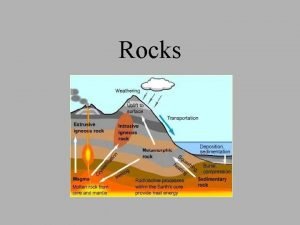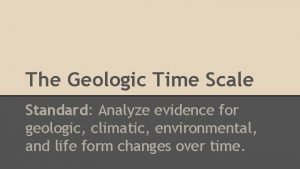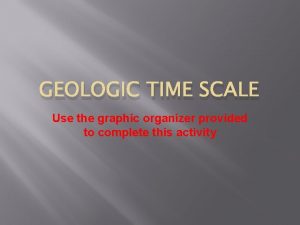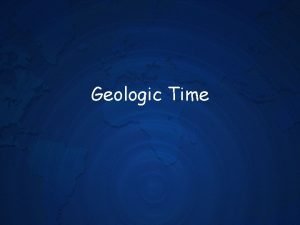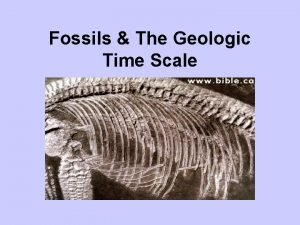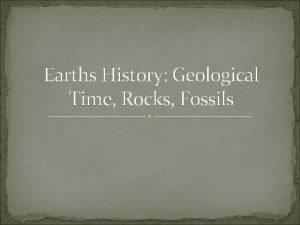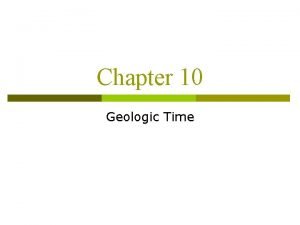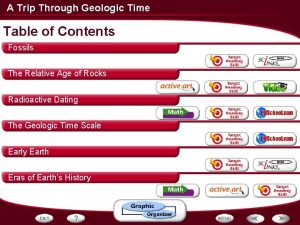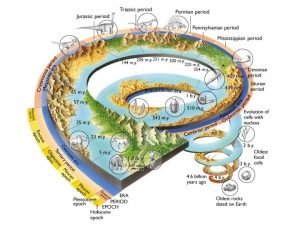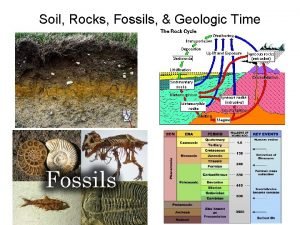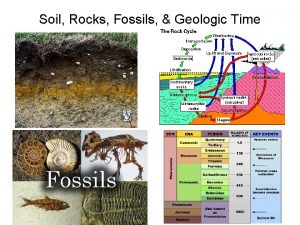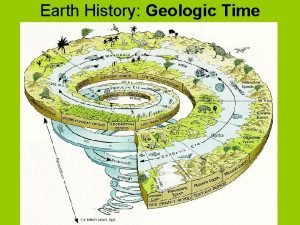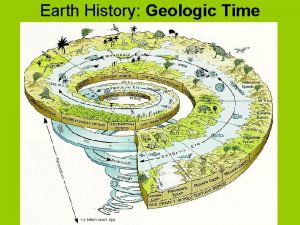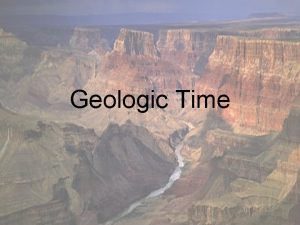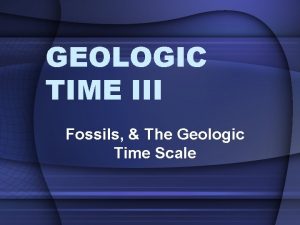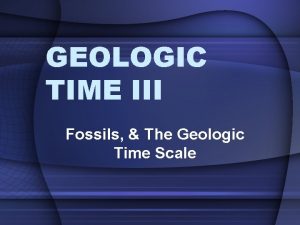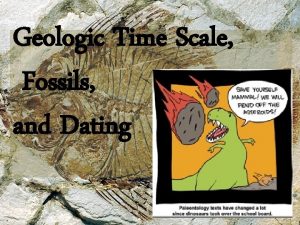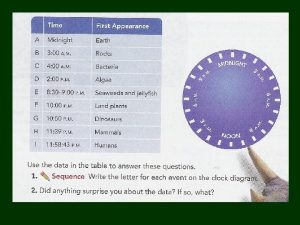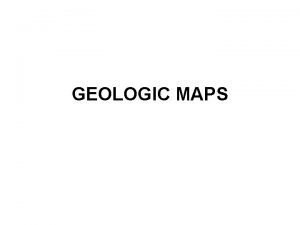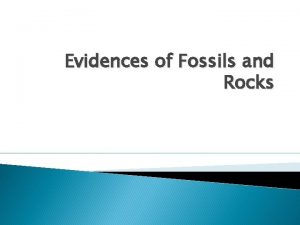Soil Rocks Fossils Geologic Time Soil a mixture













- Slides: 13

Soil, Rocks, Fossils, & Geologic Time

Soil: a mixture of weathered rock, decomposed organic matter (humus), water & gases • Layers: Horizon A – Topsoil – rich humus layer one foot or less Horizon B – Subsoil – clay & minerals washed down from above Horizon C – Regolith – transition layer of partly weathered rock Horizon D – Bedrock • Soil Conservation (conservation is using natural resources wisely) –Can take more than 100 years to create 1 inch of topsoil

Rock Cycle: the process where rocks are formed, destroyed, and formed again in Earth’s crust • Igneous Rock : formed by cooled molten material (grainy or glassy). • Metamorphic Rock: formed by changing existing rock through heat and pressure • Sedimentary Rock: formed through deposition of sediment called lithification (thin layers). - Lithification: the process of turning sediment into sedimentary rock: Weathering → Erosion → Deposition → Compaction → Cementation → Sedimentary Rock

Pluton: an intrusive igneous rock body • Sill forms when magma intrudes parallel rock layers • Dike forms when magma invades vertical cracks in rock layers, cutting across preexisting rocks • Batholith is a large, irregular shaped pluton of at least 100 km 2 (Stock if less than 100 km 2) • Laccolith is a lens shaped pluton with a round top and flat bottom. It is relatively small, no more than 16 km wide.

Weathering → Erosion → Deposition Cycle Weathering: the process that breaks rock into smaller pieces • physical/mechanical : Breaking rocks into smaller pieces that does not involve any change in the composition of the rock, only changes in size or shape occur. examples: Wind, water, abrasion, temperature, plant roots, & animal actions. • Frost wedging occurs because water expands when it freezes.

• Chemical weathering: the process by which rocks and minerals undergo changes in their composition due to water & acids from nature (plants, fungi, gases in the air, etc. ) • Erosion: the process of carrying weathered rocks away • Agents of erosion: wind, water, ice, & gravity - The rock fragments are then deposited on the crust.

Mass Movement. • Slump: when the mass of material in a landslide moves in large mass, leaving crescent shape scars • Slide: a rapid, down slope movement of Earth materials that occurs with a sudden separation from underlying materials • Creep: a slow, steady, downhill flow of loose, weathered Earth materials (as little as a few cm/year) • Flow: Earth materials flow as if they were a thick liquid (a few cm/year up to 100’s km/hr) • Fall: when a rock loosened by weathering, breaks off and falls directly downward off a cliff or overhang. • Increases in water increases total weight and lubricates grains between sediment reducing friction between particles contributing to mass movements.

Relative Dating • Law of Superposition: the geologic principal that states that in horizontal layers of sedimentary rock, each layer is older than the one above it, and younger than the one below it. • Intrusions and Extrusions are used in relative dating of rock layers. • Extrusion: igneous rock that is younger than rock below it • Intrusion: igneous rock that is younger than rock below it or around it • Law of Cross-Cutting Relationships: any fault or intrusion is younger than the layer it cuts through. • Law of Included Fragments: any fossils or rock fragments found in layers were deposited at the time the layer formed.

Fossils • A fossil is the preserved remains or impression of a prehistoric organism • A scientist who studies fossils to learn about organisms that lived long ago is a Paleontologist. • Types of fossils: 1. Preserved Remains – unchanged, or nearly unchanged remains preserved in tar, amber, or ice protecting it from decay 2. Petrified – minerals replace all or part of an organism

3. Carbon Film – a thin coating of carbon left on rock by organic gases of decomposition. 4. Molds & Casts – a hollow place in the sediment forms from the dead organism, the mold is later filled in with new sediment to form a cast. 5. Trace Fossils – show evidence of organism activities • To be classified as an index fossil that is used to tell the age of a rock layer, the fossil must be found in many areas and the organism must have existed for only a short geologic time frame.

Past Environmental evidence found in rock layers • Ripple marks found in sandstone in a desert tell you that the climate/environment used to be a shallow sea. • Limestone in KY tells us that KY use to be under a shallow sea. • Tropical plant fossils in cold climate (Alaska) tell us at one time its climate use to be warm, moist, tropical. • Glacier tracks in warm areas (Ohio) tell us at one time it’s climate used to be cold & under glacial ice.

Radiometric Dating: using radioactive decay to give an exact age to a fossil or rock • Half-Life: used in dating of radioactive substances. Every half-life the radioactive substance decays into another substance. Example: C-14 has a half-life of 5730 years in which half of it decays into N-14. If a fossil contains 50% C-14 & 50% N-14 it is 5730 years old; if it’s 25% C-14 & 75% N-14 it is 11, 460 years old. • Other examples: K-40 to Ar-40 in 1. 3 billion years • U-235 to Pb-207 in 705 million years

Geologic Time Scale: • Precambrian Era covers 88% of Earth History • Paleozoic Era covers 7% of Earth History - 3 major events in life development during the Paleozoic: 1. Life Explodes in the water 2. Life reaches land – amphibians & plants (today’s coal were these plants) 3. ended with a mass extinction – 95+% • Mesozoic Era covers 4% of Earth History - the major groups of organisms that developed were: Reptiles (dinosaur), Birds, & Mammals - At the end of the Mesozoic Era, approximately 50% of all life on Earth became extinct • Cenozoic (current) Era covers 1% of Earth History. several ice ages have occurred. The dominant animal life is the mammal. (wooly mammoths & saber tooths) (humans arrive the latter part of this era)
 Compare geologic time with the geologic column.
Compare geologic time with the geologic column. Rock cycle
Rock cycle Igneous metamorphic and sedimentary
Igneous metamorphic and sedimentary Fossils in rocks
Fossils in rocks Fossils in sedimentary rocks
Fossils in sedimentary rocks How is the geologic time scale organized
How is the geologic time scale organized Geologic time scale graphic organizer
Geologic time scale graphic organizer How is the geologic time scale organized
How is the geologic time scale organized Geologic time scale animals
Geologic time scale animals Fossils
Fossils Geologic time scale drawing
Geologic time scale drawing A trip through geologic time answer key
A trip through geologic time answer key 4 divisions of geologic time
4 divisions of geologic time Moth scale
Moth scale



